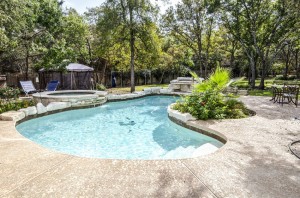 Children under five years old are at greatest risk for accidental drowning and near-drowning. Nothing can replace adult supervision in protecting young children from swimming pool accidents, but a proper pool fence add a layer of protection for children in your household and neighborhood kids who may wander into your yard.
Children under five years old are at greatest risk for accidental drowning and near-drowning. Nothing can replace adult supervision in protecting young children from swimming pool accidents, but a proper pool fence add a layer of protection for children in your household and neighborhood kids who may wander into your yard.
Pool Fence Basics
- Your pool fence should be at least four feet tall. The top of the fence should be at least 48 inches above grade, measured on the side of the fence facing away from the pool.
- To prevent children from crawling under the fence, the bottom of the fence should be no more than four inches above grade if the surface is hard, such as concrete, and no more than two inches if the surface is soft, such as grass or dirt.
- Gates should open out – away from the pool. They should close automatically on their own and be self-latching.
- The gate latch release should be on the inside – the pool side of the fence.
- To keep children from reaching through the fence to open the latch, any gap or opening within 18 inches of the latch should be no more than one-half inch wide.
- To keep children from reaching over the fence to open the latch, if the latch is less than 54 inches above the ground, it should be at least three inches below the top of the gate.
- Horizontal members can be used as footholds for climbing. To prevent this, the members should be on the pool side of the fence if the tops are less than 45 inches apart, and the vertical members should be no more than one and three-quarters inches apart.
- If the tops of horizontal members are at least 45 inches apart they can be on the outside of the fence and vertical members can be up to four inches apart.
- Decorative cutouts should create an opening of no more than one and three-quarters inches.
Be sure to check your local laws for pool fence regulations. Some jurisdictions have stricter requirements such as a taller pool fence.















